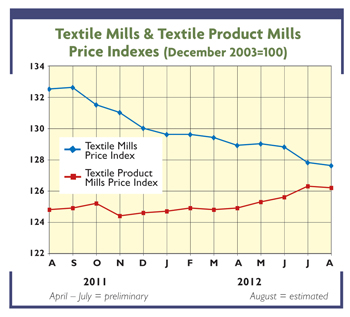Business continues to be strong for spinners in mid-September. Ring-spun yarns are in high demand,
as are a variety of polyester and blended yarns. Spinners and yarn brokers also report increased
sales of open-end yarns.
The recent surge in sales accounts for the most sustained period of brisk business for many
spinners since mid-2011, when a frenzied 18-month upcycle came to an end.
“Business has been good for some time, now,” said one spinner. “We started getting more
inquiries and orders back in July, and it has been pretty constant since then.”
A prominent yarn broker agreed: “My business has been strong since at least August. It’s
been a combination of factors, I believe. Retailers have thin stocks and are beginning to
replenish. The price of imported yarn has been increasing and the availability has been
diminishing, which brings more business back to this hemisphere.”
The outlook for the remainder of the year remains promising as well. “It looks like the
fourth quarter is going to be relatively strong, at least in comparison to last year,” said one
spinner. “I believe there may be a slight slowdown around the holidays, but I think it will pick up
again at the beginning of the new year. Hopefully, we are in for a pretty good run.”
Some spinners report that, while they have a steady pipeline of business, the size of the
orders remains relatively small. “We do a lot of short runs, a lot of changing out,” said one
spinner. “Everybody wants something just a little different, and, as always, they want it
yesterday. It puts a lot of pressure on the business to deliver.”
With the improved business conditions, order delivery times for many customers, as expected,
are increasing. “A few months ago, a two-week turnaround was about the norm, and you could get it
even faster in some instances,” said one buyer/broker. “Now, you are looking at six weeks or more
in some cases.”
Pricing Pressures Escalate
Despite the increase in both inquiries and orders, spinners are still dealing with
considerable price pressures. “We are fighting a constant battle to maintain margins,” said one
spinner with operations in both the United States and Central America. “Our customers want to place
the business. But they want it at a price that is just not sustainable for us right now. We have to
negotiate hard for every penny on the pound.”
The pricing pressure is particularly acute for smaller spinners, according to industry
sources and observers. “Large spinners have programs in place where they can accommodate business
at a price significantly less than what the rest of the industry can afford,” said one industry
insider. “A customer might call up a large spinner and say, ‘What’s your price on 30/1 combed
cotton?’ And the answer might be, ‘We are selling it for $2.10.’ Then, the customer says, ‘I want
5,000 pounds.’ And then the large spinner says, ‘I can’t sell you 5,000 pounds. I have 1,000
pounds, but that’s it. The rest of it is committed, unless you want to wait awhile.’ So, the
customer then calls a smaller spinner and asks the same questions. But the smaller spinner’s price
is $2.75. So, the customer tells the smaller spinner the price is too high and won’t place the
order. It’s a conundrum. At some point somewhere, the cycle is going to have to break. Most of the
industry can’t afford to sell yarn at those prices.”
Price Of Cotton Stabilizing
For the week ending September 14, the price for the base quality of cotton in the seven
designated markets measured by the U.S. Department of Agriculture averaged 70.19 cents per pound,
down from 71.59 cents per pound the previous week, but up from the 67.98 cents per pound reported
August 17. The price has been hovering in the 70-cents-per-pound range for the past several months,
after falling from record highs in early 2011. “Certainly, the fact that prices have stabilized
somewhat is a contributor to the increases in business most of us have seen,” said one spinner.
“Customers are beginning to realize that they can place orders and not be caught short. More than
anything, I think, our business just needs some stability over an extended period.”
September 2012





